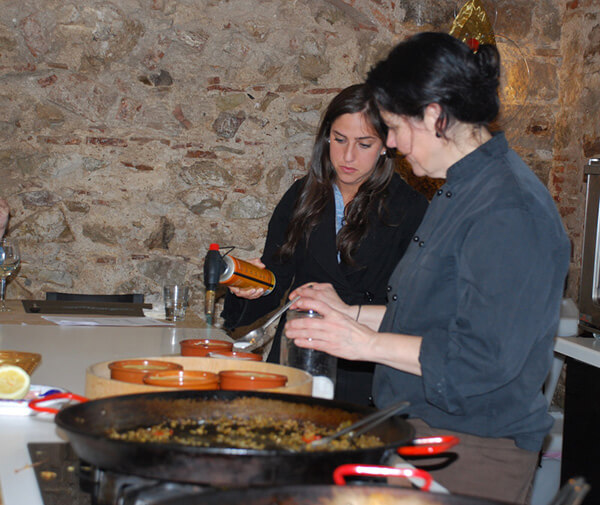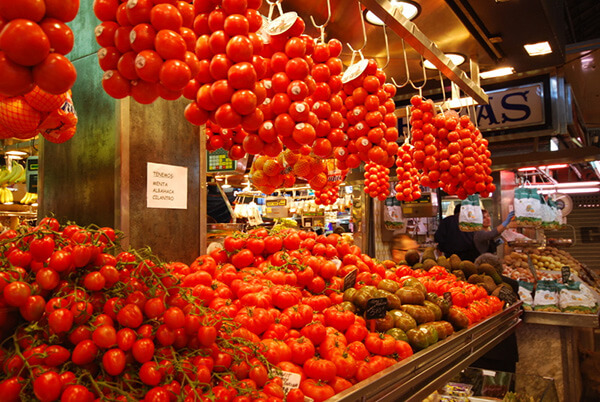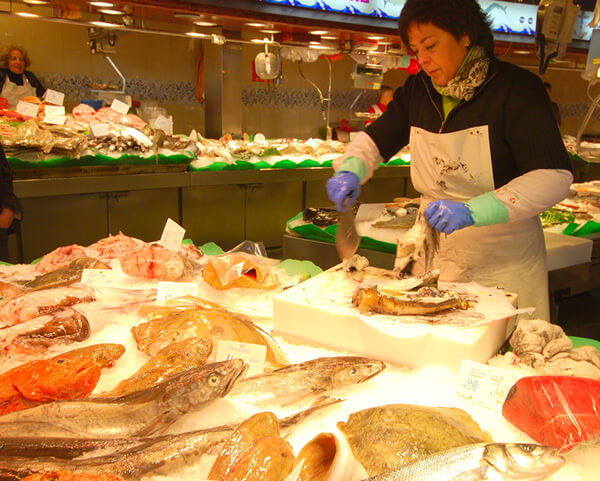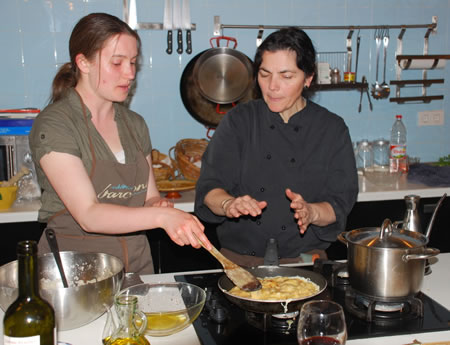A Memorable Cooking School Experience in Barcelona
Article and photos by Tom McGuire

|
|
In the Barcelona cooking class Teresa is showing a student how to make a crema Catalan.
|
In 1840 Théophile Gautier, the French poet and novelist, visited Spain. At the Pyrenees, he was told to carry biscuits and provisions since “The Spanish make breakfast with a spoonful of chocolate, lunch with a garlic clove thrown into a glass of water and dine on a cigarette.”
It got no better for him in the south of Spain where he was offered gazpacho. “In our country, no dog…would put his muzzle in such a mixture.” How things have changed. Now Spain boasts 15 3-star Michelin restaurants! Rioja wine and paella are enjoyed all over. Today, a visitor can eat well in Spain on any budget — and learn to cook.
As a boy, I wasn't allowed near our kitchen's big white Kelvinator stove. Tinned tuna was our only fish, and only on Fridays. Our weekday lunch was PB&J on white bread, and pepper was almost sinful. My ignorance of real food and cooking lasted into my adulthood — until I came to Spain.
How to Cook Like a Barcelonian?
Since then, I have become a paella snob, a power shopper, and a regular at "my" market stalls. But I wanted a more structured workshop on cooking.
Not
in the Guidebooks is a UK-based organization that coordinates hundreds of learning experiences, including cooking, photography, art, writing, and yoga. They subcontract one-day to several-week courses with local teachers worldwide.
Not in the Guidebooks offers
several cooking courses in Spain.
One was too expensive for me at the time. Another 5-day course
was close but I didn’t have the time. But the 1-day Spanish Cooking Course
and Tour of the Boqueria Market in Barcelona
was just what the aspiring chef wanted. Barcelona is steeped in food.
Robert Hughes, in “Barcelona: The Grand Enchantress” says “I
can’t imagine Barcelona without it.” But why? I went
to find out.
The more complex and colorful a people's history and the variety of other races it has come into contact with serve to enrich its cuisine. Barcelona has undoubtedly enjoyed a complex and colorful history: Phoenicians and Greeks, Carthaginians in 3 B.C., and the Romans brought better irrigation, roads, and olives to Spain. But the Moors added even more after 711 A.D., with oranges and rice in particular. These years of upheaval and hunger after the Spanish Civil War, and most recently, mass tourism, have left their mark on the Catalan menu.
Barcelona is my favorite Catalan food center. It is a city born of the sea that bathes it, the land that cradles it, and the history that shaped it. It's the port where Columbus landed with chocolate and tobacco. It is full of history, culture, art, and perpetual motion. The centuries-old center, the Bario Gotico, is a labyrinth of nooks and alleyways, and it is not without its dark side. But the hovels and dives that sheltered the likes of French author and petty criminal Jean Genet have mostly been cleaned up. Of course, I enrolled in the school.
Finding and Going to the Right Cooking School
in Barcelona
Early one morning, I followed my map to C/del Paradis, near the city hall Plaza, but a side street away in light and cleanliness. One should not judge a cooking course by the solid graffiti-covered metal street door that enclosed it. But I was early, or rather, since it is Spain, I was on time — but no one else was.
Twenty minutes later, I wandered back and found the doors open. I stepped into a long, decorated space with a table seating 12 facing a modern cooking area, knives on magnetized bars, paella pans, jars of spices, an oven, and a stainless steel fridge.
Teresa, the Galician-born but Barcelona resident, apologized, blaming it for traffic. I introduced myself. She offered me a glass of water, and I sat down while she busied herself to prepare the table. We chatted in Spanish, though her English was excellent. She had worked in the kitchen of a 5-star hotel in the city but grew tired of the 17-hour days and stress. She had been with the Cook & Taste cooking school almost three years.
The nine other participants drifted in, excusing themselves by saying they could not find the place or did not believe that it was down this dark side street. I couldn't blame them. There was a New York couple with two daughters and a granddad. The girls had been in Barcelona studying business. A couple from Australia made the typical month-long visit to Asia and Europe, and a brother and sister from Canada did the same. The sister had also been studying in Barcelona. It was a good mix of ages, countries, and backgrounds.
With Teresa’s help we had been putting together a 4-course Spanish lunch menu starting with a shot of tomato soup, a bit like a mini-gazpacho, tortilla and pa amb tomaquet, seafood paella, and crema Catalana for dessert. But first we went shopping. No frozen stuff in her kitchen.
The Mercado Boqueria

|
|
The Barcelona cooking class at the market and about to indulge in purchasing a variety of tomatoes.
|
The Mercado Boqueria, a city tourist site, was a short walk away. We followed Teresa through the plaza and down c/Boquerie to the Ramblas, keeping sight of her green shopping trolley as closely as gulls after a fishing boat.
Almost any travel book in Barcelona mentions this market and with good reason. We stood at the entrance with its cut glass arch set back from the busy Ramblas. Teresa gave us the background. It was the site of a convent of Carmelite nuns that had burnt down in 1835. This opened up space, and meat vendors first took over the area; it was a Boqueria Catalan or something like a butcher's area. Soon, other vendors of every kind joined them, selling fresh fish, fruits and vegetables, mushrooms, etc
The city recognized it in 1836 and covered it in 1914. It is the largest covered market area in Spain. The market is not for the light-hearted: You will see whole suckling pings, brains, tripe, and skinned sheep heads. You look at your lunch differently after you have looked it in the eye.
Tomatoes figured in two of our dishes, and Teresa wasted no time, leading us to a stall with big, small, very ripe, mature, even yellow and wrinkled tomatoes. She told us that since Catalans eat everything, they like a bit of variety.
Teresa was a regular in the market and stopped and chatted with the well-dressed and coiffed woman behind most of the fields of ice and fish or mounds of veggies. A school of shiny, bright-eyed fish stared up from the ice, almost all from the Mediterranean ocean a few kilometers away. Perhaps the fish were caught from Galicia early that morning and expressed to Barcelona. Some fish still had hooks and bits of line in their mouths. We got calamari from Toni at Mariscos Pi, where the language was shifted to Gallego.
Shellfish, cheese, rice (bomba rice from Valencia). Our New Yorker commented on the size of a flounder. Our Australian said that where he came from, they used to fish that size for bait.

|
|
The Barcelona cooking class went shopping for squid at the market.
|
We had already done our shopping, which was all done in cash and was not expensive, so we went back to the school.
The Role of the Potato
One Spanish eating delight is tortilla de potato. Along with rice, the potato is a fine indicator of Spain’s history. Potato is probably from the batata (sweet potato) that Columbus brought from the New World, though the origin of the introduction of the potato is somewhat controversial. First considered nothing more than a curiosity grown in monastic gardens, and even poisonous, it later became a staple especially for the poor and peasants throughout Europe.
Cultivated for three millennia in South America, the variety we know of was brought to Spain in the last part of the 16th century. It's inexpensive, easy to grow, long-lasting, and it soon spread all over Europe.
Spring is an excellent time to select potatoes for our tortilla, especially Teresa's Kennebec favored variety.
It was to start our stomach working, she said. To make a fluffier tortilla, we separated the white and yokes of three eggs, beat them, and then mixed them. The potatoes were just turning color in the oil. Our Canadian brother and sister added them to the two frying pans. Teresa wanted them to try flipping the tortilla in the pan. "It's all in the wrist," she said. Rebecca's flip was a success, but Jeff needed Teresa's hand to reshape his efforts into something resembling a round one. The results? Per mullar pa. "Good enough to dunk your bread in," as the Catalans say.

|
|
Barcelona cooking class, where Raquel cooks her tortilla.
|
Making the Paella
After starters, our main dish was shellfish paella. Well, it would be. We were in Barcelona. Rice is the most consumed grain in the world and has been grown for centuries. Introduced by the Romans and cultivated by the Moors, it was a staple in medieval times, and today, it is on any menu. It reflects the heritage of 781 years of Moorish influence here. They brought irrigation systems that helped make the Mediterranean coast one of the main rice growing areas in the country.
The Moors occupied Catalunya relatively briefly, but their culinary impact cannot be overstated. Not only rice but eggplant, cane sugar, saffron, and the palm trees that line my street are part of their legacy.
Like many Spanish dishes, paella is named after the dish in which it is cooked. The flat, shallow metal dish in which the rice and other ingredients are cooked is called a paella.
Simple dishes using basic ingredients show the impact of centuries of poverty and peasant culture in Spain. Like many dishes, they were cooked by the men in the fields around Valencia. Barcelona has always looked to the sea more than the mountains. We had prawns, squid, clams, and fish stock — not the chicken or rabbit, so traditional in Valencia. Teresa also varied from the Valencian variety by frying the rice instead of boiling it.
A vegetarian would have gone hungry in Spain only a few years ago. They eat every part of the animal, from bulls' tails to pig snout and most parts in between. We had two paellas, one made with shellfish and one with vegetables.
Cooking with Love
Our New York grandfather needed help converting the metric measures in our recipe booklet to the Imperial system. Teresa assured him that when you baked, you followed a recipe, but when you cooked, you followed your taste. Love had more to do with it than level teaspoons.
I knew that a single man's wife was a microwave, but Teresa told us that a good cook's best friend was a sharp knife. She showed us which knife was best to cut the artichoke from the stem (serrated) and how to place it against our knuckles and not our fingernails while chopping. She explained why the paella pan was dimpled: to keep the metal from warping on the heat. We learned how to season a new pan, how a dash of vinegar helped, and how to keep the pan coated with oil after use.
We learned not to stir the rice after it had started cooking. Just before it was done, we added saffron threads. It was fascinating to see Teresa put the threads in an aluminum foil envelope and pass it over the flame to toast them.
It had been four hours since we went shopping until we had greedily spooned up the last of the crème Catalan from our bowls. When friends ask what the Mediterranean diet is, I tell them it is not just what you eat but how you eat it. It is about taking time, sitting at a table with family and friends, taking a siesta after or a paseo. We enjoyed that way of eating. It did not hurt that the school had someone come in to wash and clean up after us. We thanked Teresa, exchanged email addresses, tucked our food-stained menu booklets away, and went our separate ways.
Barcelona and Food
So what was it about eating in Barcelona? Miguel Unamuno had reservations about the arrogance, persecution complex and narrow mindedness of the people. Don Quixote said Barcelona was “the seat of courtesy, the haven of strangers.” But he was crazy…
The only problem I have ever had with a taxi driver was in Barcelona. Change has diluted much of the city. It is more tourist-friendly, but petty crime abounds, and fast food joints are within littering distance of each other. But it can be perfect when the city and its food are good.
Nutritionally, it embodies all the best of the Mediterranean diet: fresh local foods, lightly seasoned, well cooked, and served with good bread.
True, it is not generally physically appealing food — think black rice. But even in the 14th century, Francesc Eiximenis, a theologian, wrote, "Catalans eat more graciously than other people."
So…I think Barcelonian food is best summed up by the fact that people work to live and love to eat. People here see eating as a way of sharing: "It was all right to love food in society."
So put up with the petty problems, find a back street restaurant and Bon Profit or enjoy.
For More Information
on Cooking Classes in Barcelona
Cook&Taste Barcelona Cooking Classes, open since 2004, offers several cooking class options, including group, private, and foodie walking tours.
Barcelona Paella Experience offers regular cooking classes in Barcelona.
Barcelona Cooking offers regular cooking classes, including tapas preparation and tours on an hourly or daily basis. The school even offers a study abroad program for teens and beyond.
Just Royal BCN offers group cooking classes and workshops in Barcelona, including the preparation of paella.
Tom McGuire is an Irish expat who has lived and worked in Spain for over twenty years. He is very taken with the sun, sea, and sand, as well as the food and travel. He enjoys a good face-to-face talk over paella and wine.
|
